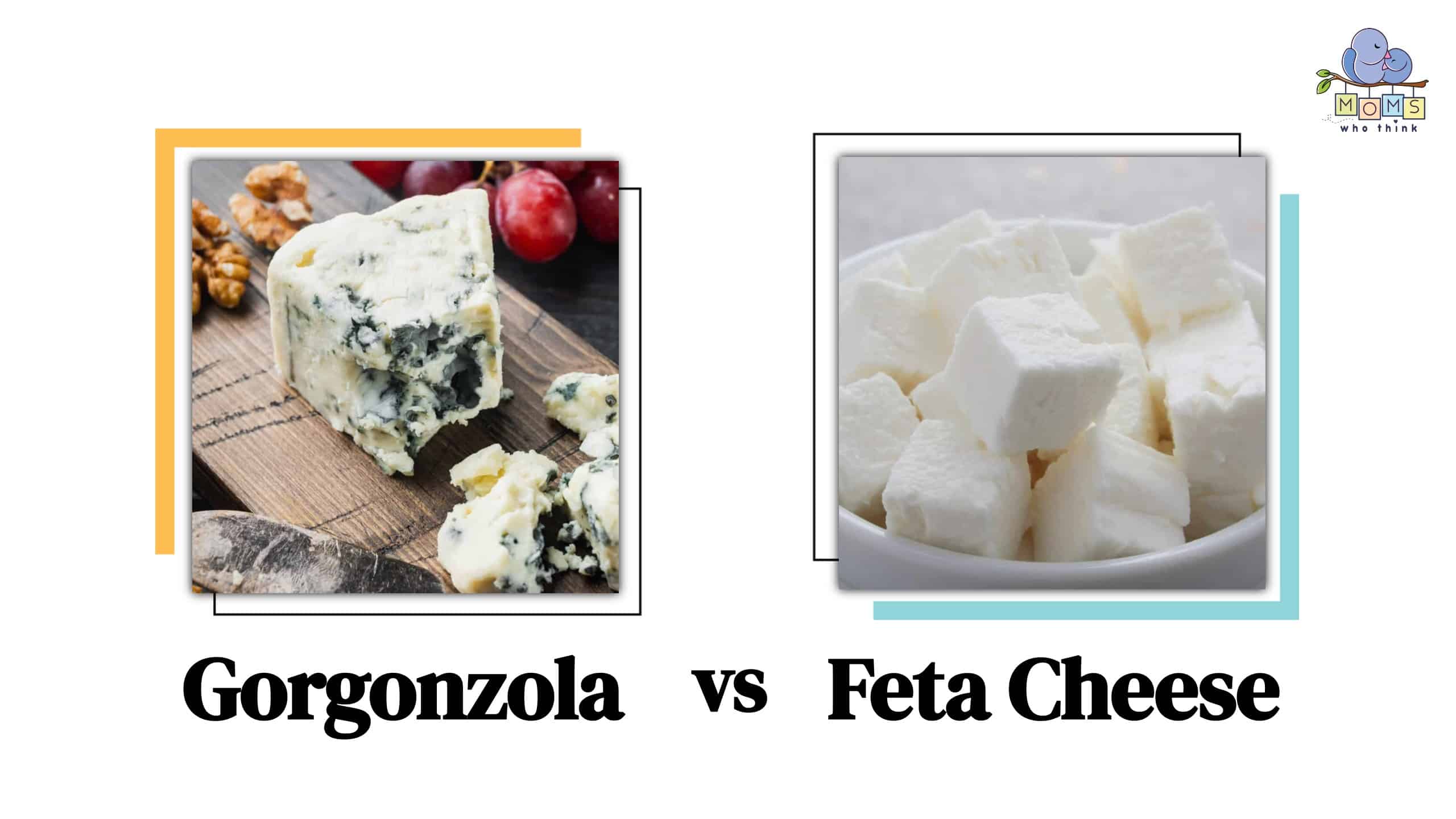Gorgonzola and feta cheese are two of the most popular cheeses worldwide. Although they are both loved by many for their unique flavors and versatile uses in the kitchen, they differ substantially in origin, production, and flavor. Each has its own unique taste, texture, and culinary uses.
In this post, we'll take a closer look at the differences between gorgonzola and feta cheese to help you decide which one is the right choice for your next recipe.
Gorgonzola vs. Feta Cheese: What is the Difference?
Gorgonzola and feta have many unique differences. Gorgonzola, for example, is native to Italy, made of cow's milk, and has a smooth texture. Feta is native to Greece, made of sheep and goat's milk, and has a crumbly texture.
Let's take a deeper look at the variations between these two cheeses.
What is Gorgonzola?
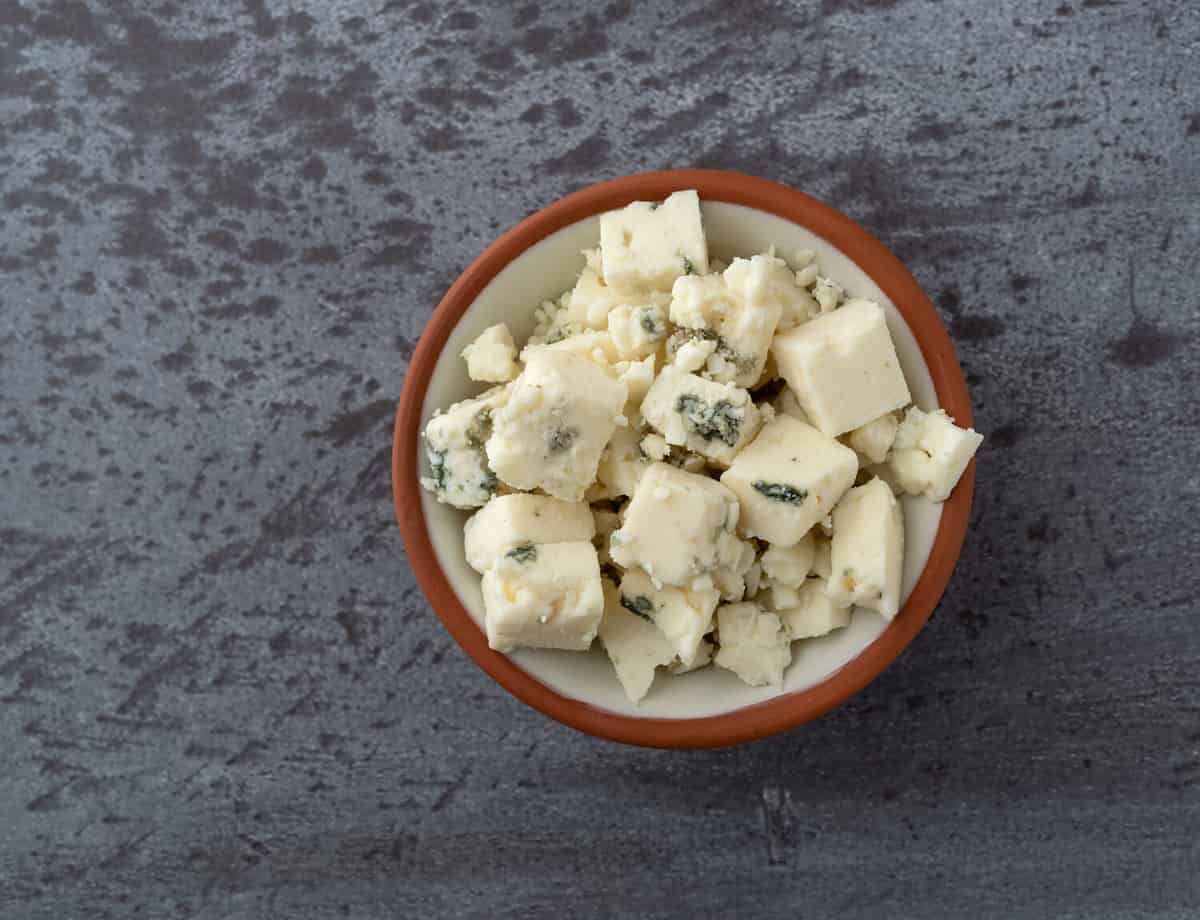
Gorgonzola has signature blue-green coloring, similar to blue cheese.
©Toasted Pictures/Shutterstock.com
Gorgonzola is a type of blue cheese that has white color on the outside and blue-green streaks on the inside. It has a unique aging process and many uses in Italian cuisine.
Origin
Gorgonzola is uniquely named after the town of Gorgonzola, Italy, where it was first made in the 11th century. The Northern Italy region still famously makes this cheese today, but it is also produced worldwide.
Characteristics and Texture
Gorgonzola is made from unskimmed cow's milk and is aged with a Penicillium fungus, which gives it its distinctive blue-green veins. Because this cheese is not pressed in the production process, it has a very creamy, moist texture that can range from soft to crumbly, depending on the age of the cheese.
There are two types of gorgonzola: Gorgonzola dolce, which is young and creamy, and Gorgonzola piccante, which is aged for longer and has a stronger and sharper flavor.
Flavor
The flavor of gorgonzola is tangy, pungent, and very distinct. It often resembles blue cheese but tends to be a bit milder. The flavor will also depend on the type of gorgonzola cheese made – dolce or piccante – and how long it's aged.
Production
As mentioned, gorgonzola is made of pasteurized cow's milk. The milk is heated and combined with a starter culture and rennet, which causes the milk to curdle. The curds are then placed in a mold and metal rods are inserted to create holes that allow for air to circulate and the mold to grow, giving the cheese its signature blue-green streaks.
At this point, the cheese is left to age anywhere from a few months, up to a year. During the aging process, the cheese is usually stored in a cool, humid environment, where the blue mold can grow and spread throughout the cheese. The aging time for gorgonzola can vary depending on the desired flavor and texture.
Popular Uses
Gorgonzola is often used in Italian cuisine, where it is added to pasta dishes, risotto, pizzas, and salads. It can also be served on a cheese board, as a spread, or used to create different types of sauces or toppings.
Nutritional Value
In terms of nutritional value, gorgonzola cheese is a good source of calcium, protein, and vitamins A and D. However, it is also high in fat and calories, so be sure to consume it in moderation.
What is Feta Cheese?
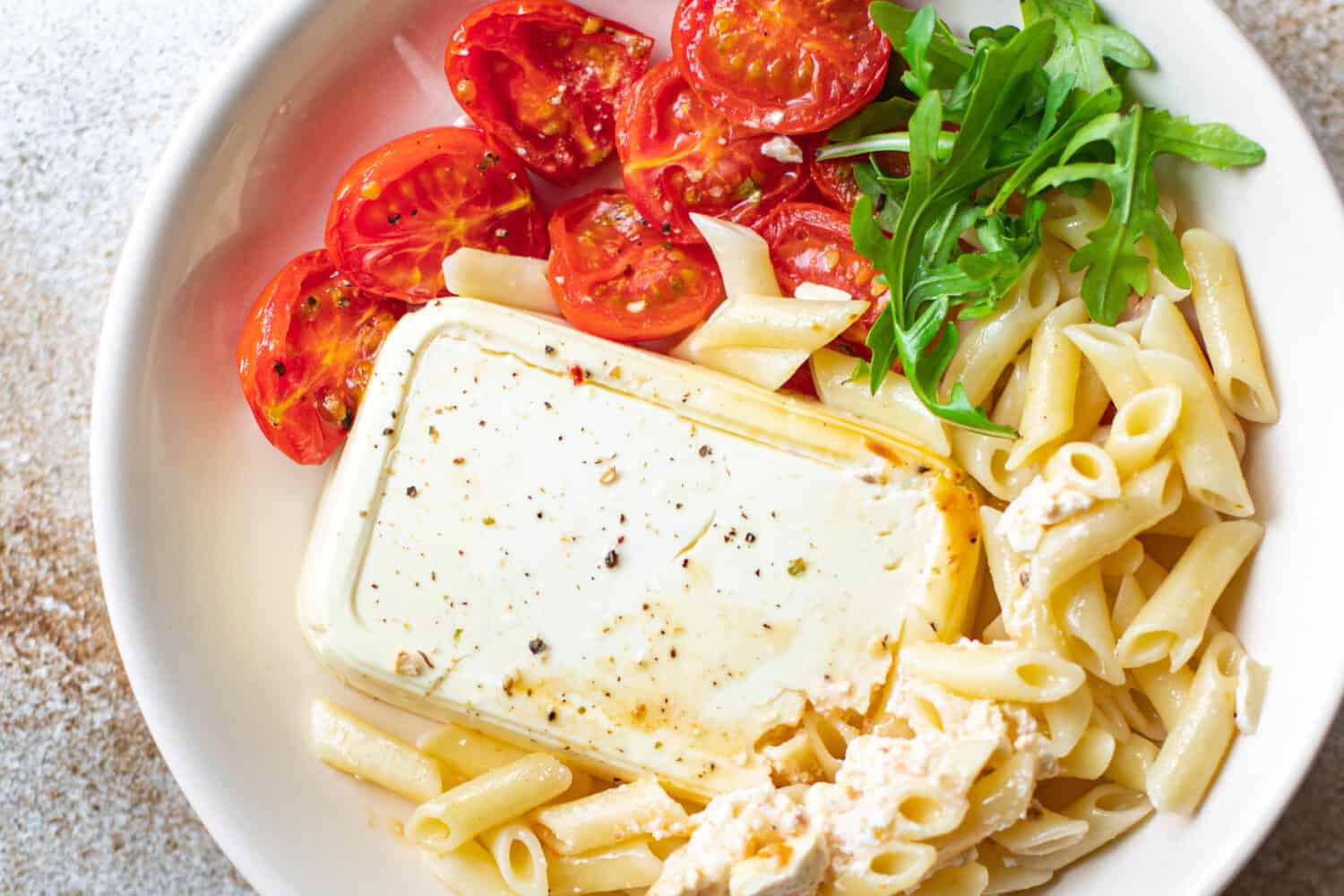
Feta cheese is often shaped into blocks or cubes and pairs well with Mediterranean cuisine.
©Shadow Inspiration/Shutterstock.com
Feta cheese is a cheese that is primarily made from sheep's milk. It can also be made with a small portion of goat's milk, but it never contains cow's milk which sets it apart from gorgonzola. Feta is placed in a brine solution which gives it its signature salty flavor.
Origin
True feta cheese originates from Greece, making it a popular cheese for Mediterranean-style dishes. However, this cheese is now manufactured all over the world, meaning it can range in texture and flavor depending on where it was produced.
Characteristics and Texture
Feta cheese is typically firm, white, and crumbly. Greek feta cheese can be difficult to spread and may have a grainy texture to it.
Other types of feta cheese can vary in texture. For instance, French feta tends to be mild and creamier, while Bulgarian feta can be slightly less salty. What kind of feta cheese you purchase and use will depend on where it's produced.
Flavor
Feta typically has a tangy, sharp, and salty flavor. The saltiness comes from the brine solution that is used for aging, and the level of saltiness will depend again on where and how the cheese is made.
Production
Similar to gorgonzola, the process of making feta cheese involves curdling the milk with rennet. Then the curds are allowed to drain in cheesecloth for several hours. The cheese is often cut into blocks or cubes, which is often how it's sold after it's aged. Once the cheese is cut, it's placed in a brine solution made from water and salt. This solution helps to preserve the cheese and gives it its characteristic flavor and texture.
It's important to note that the aging process is one thing that truly sets gorgonzola apart from feta. Gorgonzola can be aged for several months, up to a year, while feta is only aged for up to two months.
Popular Uses
Feta cheese is a versatile cheese that has a use in many different types of dishes. Chefs use it in everything from salads and sandwiches to pasta and pies. It pairs well with a variety of ingredients, such as olives, tomatoes, and cucumbers, and it is popular in Mediterranean-style cuisine.
Gorgonzola vs. Feta Cheese Nutritional Value
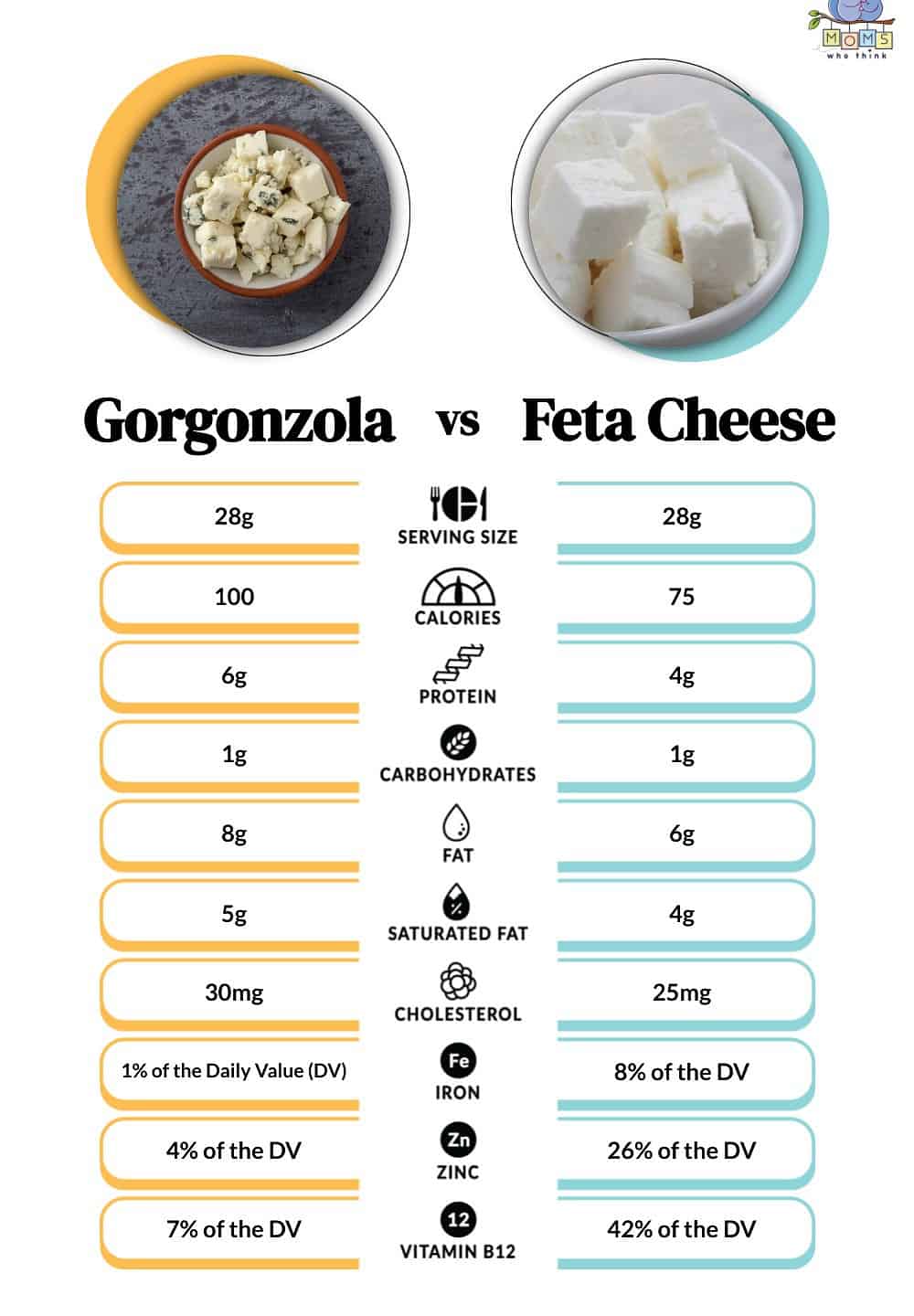
A comparison of gorgonzola and feta cheese's nutritional values
©
While feta cheese still offers nutritional value like calcium and protein, it's also high in saturated fat and sodium, so you should consume it in moderation. It does, however, have less saturated fat than gorgonzola.
What Are Good Substitutes for Gorgonzola and Feta Cheese?
It's important to note that while gorgonzola and feta cheese have some similarities in their texture and tangy flavor, they are not interchangeable in recipes. Their distinct flavor profiles and differing milk bases can alter the taste and texture of your dish.
Gorgonzola's strong and pungent flavor and its creamy texture make it a popular choice for salads, pizzas, and pasta dishes. It pairs best with bold flavors like walnuts, pears, and balsamic vinegar. On the other hand, feta's crumbly and tangy texture makes it ideal for use in Mediterranean and Greek dishes like salads, omelets, and dips. It pairs well with flavors like olives, tomatoes, and cucumbers.
If a recipe specifically calls for gorgonzola or feta cheese, it's best to use the cheese that the recipe calls for. However, if you're in a pinch, these two kinds of cheese have individual substitutes that you can try.
Best Substitutes for Gorgonzola
- Blue Cheese: Blue cheese is also aged with a blue mold, similar to gorgonzola. It also has a tangy and salty flavor that is similar to gorgonzola, but blue cheese's flavor tends to be slightly stronger. It can be used as a substitute in recipes like pasta dishes, salads, and pizza toppings.
- Roquefort: Roquefort is a French blue cheese made from sheep's milk, aged with a blue mold, and has a sharp and tangy flavor that is similar to gorgonzola. It can be used as a substitute in recipes like salads and dips.
Best Substitutes for Feta Cheese
- Queso Fresco: Queso fresco is a crumbly, soft cheese that is popular in Mexican cuisine. It has a mild and slightly salty flavor that is similar to feta. It's good in a variety of dishes, including salads, omelets, and tacos.
- Halloumi: Halloumi is a salty, semi-hard cheese that is common in Mediterranean cuisine. It has a firm texture, allowing you to grill or fry it, as well as a mild and slightly tangy flavor that is similar to feta. Use it in salads, sandwiches, and wraps.
- Goat Cheese: Goat cheese is a soft, tangy cheese that is similar in texture to feta. It has a mild and slightly sweet flavor that pairs well with salads, pasta dishes, and sandwiches.
Gorgonzola Recipes
Feta Cheese Recipes
Can Gorgonzola and Feta Be Used Together?
These two cheeses have differing tastes and textures; they're often used separately for this reason. But, mixing cheeses together can introduce a whole new flavor profile to a recipe. Since both cheeses have strong, distinct flavors, they'll both stand out in whatever dish they're used in together. The somewhat milder taste of gorgonzola will allow the feta to stand out just a bit more, though, so they won't compete too much with one another. Consider adding both gorgonzola and feta to a pasta salad to try these two cheeses out together. It might take some trial and error to get the balance just right!
If you end up liking the combination of gorgonzola and feta cheese, grab a few other recipes to try this combination out in. Any recipe that has other distinct flavors will work well, since the strong flavors of both of these cheeses will blend in well. Salads will probably be the easiest to use both cheeses in, but get creative and try the two together in whatever recipe you want!
Final Thoughts
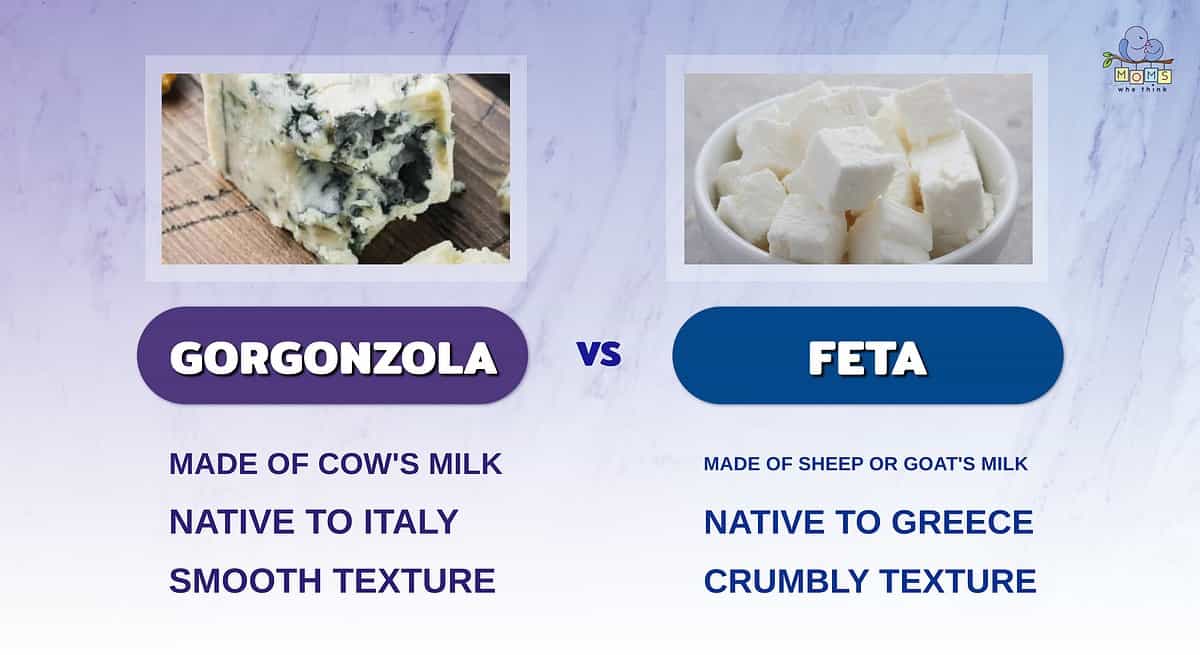
- One of the major differences between gorgonzola and feta is the type of milk that they're made with. Gorgonzola is made of cow's milk, while feta is generally made of sheep or goat's milk.
- Feta is native to Greece, while gorgonzola is native to Italy.
- The texture of gorgonzola is smooth, while feta is crumbly.
In summary, gorgonzola and feta cheese are both versatile cheeses with distinct flavors and textures. Understanding their differences and unique qualities can open up a world of culinary possibilities, from adding a bold twist to a classic dish to exploring new and exciting flavor combinations.
At the end of the day, whether you prefer the creaminess of gorgonzola or the crumbliness of feta, both cheeses offer a delicious and unique taste that can elevate any meal.
Still searching for a great recipe? Check out these feta cheese fold-overs:
Print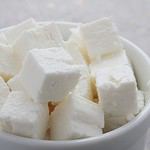
Feta Cheese Fold-Overs
- Total Time: 26 minutes
Ingredients
- 8 ounces feta cheese, crumbled
- 3 Tablespoons finely chopped green onions
- 1 egg, beaten
- 1 (17.5 ounce) package frozen puff pastry, thawed
- 1 egg yolk, beaten with 1 teaspoon water
Instructions
- Preheat oven to 375°F (190°C).
- In a small bowl, blend feta cheese, green onions, and egg.
- Cut pastry into 12 (3 inch) squares.
- Place a mounded tablespoon of feta mixture in the center of each square.
- Moisten edges with water, and fold pastry over filling to form a triangle.
- Press edges together firmly with a fork to seal. Lightly brush pastries with the egg yolk mixture.
- Bake for 20 minutes in the preheated oven, or until golden brown. Serve warm or at room temperature.
- Prep Time: 6 minutes
- Cook Time: 20 minutes
